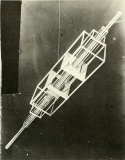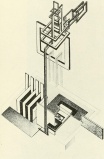Gustav Klutsis
 Klutsis at Vkhutemas, 1924. | |
| Born |
January 4, 1895 Ķoņi parish near Rūjiena, Latvia, Russian Empire |
|---|---|
| Died |
February 26, 1938 (aged 43) Moscow, Soviet Union |
| Collections | Costakis, MoMA, Tretyakov, Artic |


Gustav Klutsis (Gustavs Klucis, Густав Густавович Клуцис; 1895–1938) was a Constructivist avant-garde artist and photographer.
Contents
Life and work[edit]
A Latvian subject of the Russian empire, Gustav Klutsis came to Russia proper during the 1917 Revolution as part of a volunteer machine-gunner unit that helped to topple the czar and safeguard the new Soviet leaders, including Vladimir Lenin. Klutsis had studied painting at home and continued in art schools during and after his military service, ending up at the radically progressive Higher State Artistic and Technical Workshops (VKhUTEMAS)—the cradle of Constructivism. By the early 1920s, Klutsis had worked his way through the rigorous exploration of elemental shapes and basic materials called for by that movement and began to put the Constructivist ethos of honesty and utility to use in agitational propaganda. His designs for mobile poster stands and broadcasting towers (mostly unrealized) to be used for the fifth anniversary of the Revolution were succeeded by years of press illustrations in the rapidly developing idiom of photomontage. Klutsis adopted photography as a means of reinvesting advanced art with what he called “ideologically rich subject matter” that a mass audience would find instantly identifiable and compelling.
Klutsis brought photomontage to its peak of expression in posters from 1930 and after that blended workers’ bodies (in some cases his own) and their machines with the heads of leaders of the Soviet state to forge a collective juggernaut for modernization. These posters, printed in the tens of thousands, helped transform the Soviet visual landscape in the early Stalinist era. Nevertheless, Klutsis was killed along with scores of other Latvians on Stalin’s orders during purges later in the decade. (source)
Works[edit]
Constructions[edit]
Hanging Construction, 1921. Photograph, 20,1x25,6 cm, printed from Klutsis's negative. Costakis.
Vertical Construction, 1921. Photograph, 20,5x25,2 cm, printed from Klutsis's negative. Dimensions unknown. Costakis.
Construction, 1921. Linocut on paper, 21,5x14,2 cm. Costakis.
Skyscraper, 1922. Cover design for A. Kruchenykh's Four Phonetic Novels [Chetyre foneticheskikh romana]. Lithograph. 19,7x15 cm. Costakis.
Construction, 1922-23. Lithograph on paper, 15,5x22,1 cm. Costakis.
other[edit]
Dynamic City, 1919. Photomontage with photographic cuts, foil, gouache and pencil on paper. 37.6 x 25.8 cm. Riga, MoMA.
Design for a poster entitled The Electrification of the Entire Country [Электрификация всей страны], 1920. Photograph, 25,2 x 20,1 cm. Costakis.
Ekran. Design for Screen, Rostrum and Propaganda Stand, 1922. drawing, 34,7x19 cm. Costakis.
Uniform design, 1922. Drawing, 24,1x15,4 cm. Costakis.
Publications[edit]
- "Fotomontazh kak novyy vid agitatsionnogo iskusstva" [Фотомонтаж как новый вид агитационного искусства], in Izofront [Изофронт: классовая борьба на фронте пространственных искусств], Leningrad: OGIZ-IZOGIZ, 1931. (Russian)
- "Fotomontage in der USSR", in Fotomontage, Berlin: Staatliche Museen, 1931. Trans. of excerpt. (German)
- "Photomontage in the USSR", in Photomontage Between the Wars, 1918-1939, Madrid: Fundación Juan March, 2012, pp 131-134. Trans. of excerpt. (English)
- "Fotomontaje en la URSS", in Fotomontaje de entreguerras, 1918-1939, Madrid: Fundación Juan March, 2012, pp 131-134. Trans. of excerpt. (Spanish)
Catalogues[edit]
- Gustavs Klucis: en el frente del arte constructivista: obras del Museo Nacional de Arte de Letonia y de otras colecciones, Cajasol Obra Social, 2009, 54 pp. (Spanish)
Literature[edit]
- Christina Lodder, "Gustav Klutsis", in Lodder, Russian Constructivism, Yale University Press, 1983, pp 42-45. (English)
- Margarita Tupitsyn, Gustav Klutsis and Valentina Kulagina: Photography and Montage after Constructivism, New York: International Center of Photography, and Göttingen: Steidl, 2004, 255 pp. (English)
- Klemens Gruber, "An Early Staging of Media: Gustav Klutsis's Loudspeaker Stands", Acta Univ. Sapientiae 2 (2010), pp 125-132. (English)
- Iveta Derkusova, "The Most Recognised Latvian (?) Artist in the World. The Case of Gustavs Klucis", Studies on Art and Architecture 3-4 (2012), 30-55. (English)











